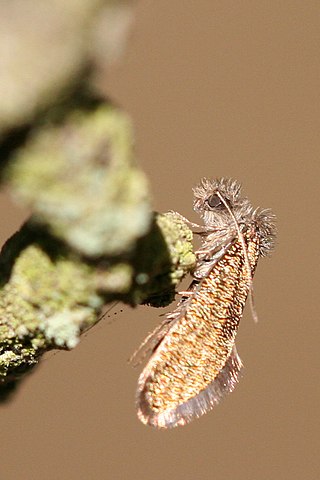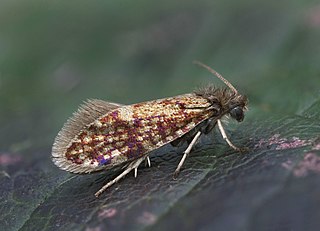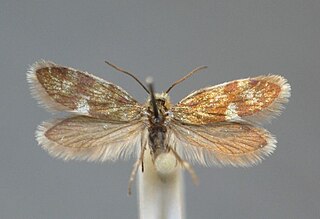
Eriocraniidae is a family of moths restricted to the Holarctic region, with six extant genera. These small, metallic moths are usually day-flying, emerging fairly early in the northern temperate spring. They have a proboscis with which they drink water or sap. The larvae are leaf miners on Fagales, principally the trees birch (Betula) and oak (Quercus), but a few on Salicales and Rosales.

Sakhalin Koreans are Russian citizens and residents of Korean descent living on Sakhalin Island, who can trace their roots to the immigrants from the Gyeongsang and Jeolla provinces of present-day South Korea during the late 1930s and early 1940s, the latter half of the Japanese colonial era.

Dyseriocrania subpurpurella is a diurnal moth from the family Eriocraniidae, found in most of Europe. The moth was first named by the English entomologist, Adrian Hardy Haworth in 1828.

Eriocrania semipurpurella is a moth of the family Eriocraniidae, found from Europe to Japan and in North America. It was first described by James Francis Stephens in 1835. The species closely resembles Eriocrania sangii and the larvae of both species mine the leaves of birch.

Kintsugi, also known as kintsukuroi, is the Japanese art of repairing broken pottery by mending the areas of breakage with lacquer dusted or mixed with powdered gold, silver, or platinum; the method is similar to the maki-e technique. As a philosophy, it treats breakage and repair as part of the history of an object, rather than something to disguise.

Eriocrania sangii, the large birch purple, is a moth of the family Eriocraniidae found in Europe and described by John Henry Wood in 1891. The moth can be found flying in sunshine around birch trees and the larvae feed on birch leaves.

Eriocrania cicatricella is a moth of the family Eriocraniidae found in Europe. It was first described by Johan Wilhelm Zetterstedt in 1839. The larvae mine the leaves of birch.

Eriocrania salopiella is a moth of the family Eriocraniidae and is found in Europe. It was described by the English entomologist, Henry Tibbats Stainton in 1854. The larvae mine the leaves of birch.

Eriocrania sparrmannella also known as the mottled purple is a moth of the family Eriocraniidae, found in Europe and Japan. It was first described by the French entomologist, Louis Augustin Guillaume Bosc in 1791. The specific name honours the Swedish naturalist Anders Erikson Sparrman. The larvae mine the leaves of birch.

Eriocrania unimaculella is a moth of the family Eriocraniidae found in Europe. It was first described by the Swedish naturalist Johan Wilhelm Zetterstedt in 1839. The larvae feed inside the leaves of birch, making a mine.

Eriocrania chrysolepidella is a moth of the family Eriocraniidae found in Europe. It was first described by the German entomologist, Philipp Christoph Zeller in 1851. The larvae mine the leaves of hazel and hornbeam.

Eriocrania alpinella is a moth of the family Eriocraniidae, found in Central Europe, including Austria and Switzerland and possibly neighbouring countries.

Eriocrania is a Palearctic genus of moth of the family Eriocraniidae. The moths are diurnal, flying in sunshine, and the larvae are leaf miners, forming blotches in leaves.
Issikiocrania is a genus of moths of the family Eriocraniidae. It contains only one species, Issikiocrania japonicella, which is found in Japan.
Eriocrania breviapex is a moth of the family Eriocraniidae. It is found in the Cayuga Lake Basin of north-western New York.
Eriocrania sakhalinella is a moth of the family Eriocraniidae. It was described, in 1983 by Mikhail Vasilievich Kozlov, from a specimen found on Sakhalin Island, Russia. It is also found in Japan.
Eriocrania carpinella is a moth of the family Eriocraniidae. It is found in Japan (Honshu).
The Zainichicinema refers to the transnational film industry of Japan, South and North Korea. With the main theme on the struggles or experiences faced by the resident Korean community or individuals in Japan, the Zainichi cinema is characterized by a wide range of film genres, which encompass melodramas to Yakuza films.










